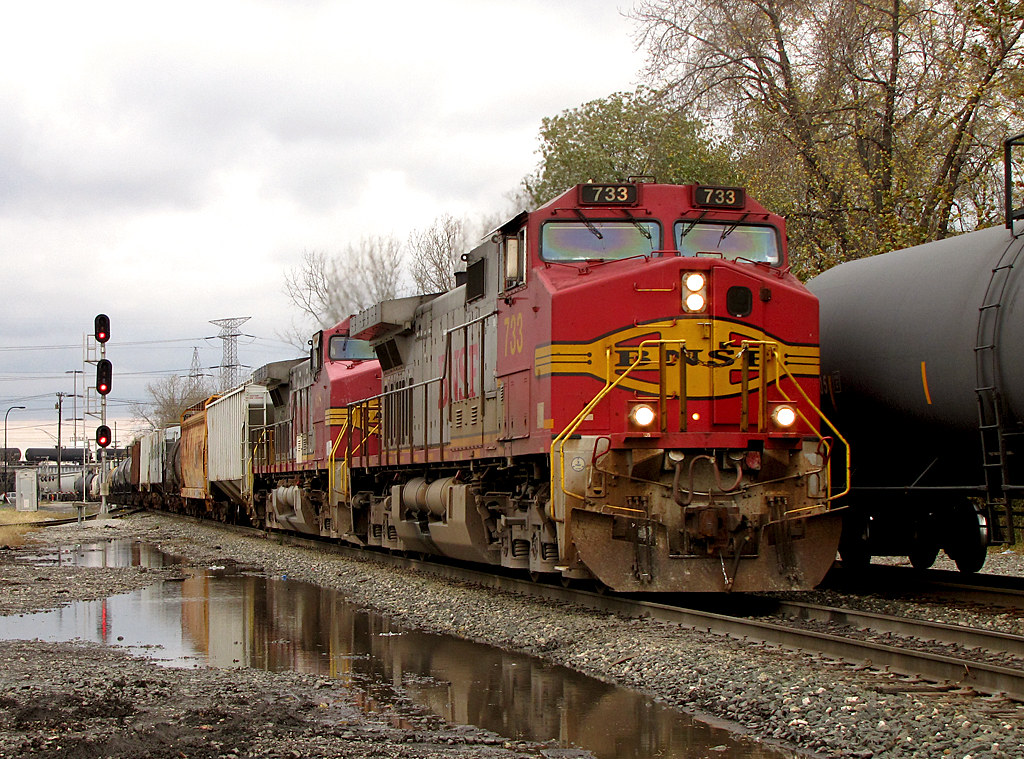
Dolton Interlocking is a popular train observation spot located in Dolton, Illinois. It is a major rail junction where multiple freight and passenger lines intersect, offering rail enthusiasts a unique vantage point to observe a variety of train operations, including complex switching and signaling activities.
Photos
Sign in to upload photos
No Photos Yet
Be the first to share photos of this location!
Dolton (Interlocking) – Dolton, Illinois, USA | Train Spotting Location
Trainspotting Experience
A typical visit rewards you with a front-row seat to genuine railroad choreography. From the small public park on the northeast quadrant, observers overlook the former B&OCT interlocking tower (now out of service but still standing), the dual diamonds, and the converging signal bridges. Expect trains to approach at roughly 40 mph on the UP main and 30 mph on the CSX side, slowing only if they receive a stop indication at the home signals. Horn echoes off nearby industrial buildings, while flange squeal accompanies locomotives negotiating the crossings. Trains can exceed 10,000 ft, so the rumble may last several minutes, punctuated by grating wheel noise as cars bounce over the diamonds. The open view lets you watch crews lining up routes via radio, and after dark the LED signal masts paint the scene in vivid reds, yellows, and greens.
Landscape, Setting & Local Atmosphere
Dolton sits on low, flat terrain characteristic of the Calumet industrial corridor. Elevation changes are minimal, giving railfans unobstructed sight lines for nearly a half-mile in all four compass points. Sparse trees and scrubby grass border the right-of-way, adding a touch of green without blocking lenses. The area feels distinctly urban-industrial: warehouses, grain transloaders, and steel service centers line the margins, yet the small park with benches and a protective fence offers a surprisingly calm vantage. Weather is classic Great Lakes—humid summers with dramatic thunderheads, brisk autumns rich in golden light, and winter days where exhaust plumes rise crisply against gray skies.
Type & Frequency of Train Activity
Conservative counts place daily movements between 90 and 110 trains:
• CSX: Manifest freights, unit ethanol and coal trains, intermodal blocks between Bedford Park and Ohio, and the daily Q-series priority stackers.
• Union Pacific: Heavy northbound grain, southbound rock, and merchandise trains connecting Proviso Yard with Memphis and Little Rock, alongside Z-series intermodals.
• Trackage-rights appearances: Canadian National road freights accessing Markham Yard via UP; Norfolk Southern detours; and the Indiana Harbor Belt’s transfers running on CSX for brief stretches.
No scheduled passenger service crosses the diamonds, yet on reroute days Amtrak’s City of New Orleans or Illini/Saluki may swing through—an unexpected treat.
Best Angles for Photos & What Railfans Enjoy Most
- Northeast Park Fence: Eye-level shots of nose-to-diamond action; morning sun favors eastbound CSX freights, late afternoon backlights UP southbounds for dramatic silhouettes.
- Old Tower Embankment: A slight rise beside the brick tower yields a ¾ view showing both railroads plus signal bridges—ideal for capturing meets.
- Southeast Corner Gravel Lot: A low angle looking north delivers head-on telephoto compositions with skyline hints in the far distance; golden hour light bathes locomotives.
Long lenses (200–400 mm) isolate power on opposite main tracks, while wide lenses (24–35 mm) embrace sweeping panoramas of the full interlocking. The constant parade and distinctive clatter over the diamonds provide audio gold for videographers.
Historical or Cultural Relevance
Dolton’s interlocking dates to the early 20th century when the Baltimore & Ohio Chicago Terminal and the Chicago & Eastern Illinois sought grade-separated access to South Chicago’s mills. The mechanical tower that once guarded the crossing served until the 1990s, one of the region’s last staffed cabins before remote dispatching. Its brick shell still stands, a silent monument to lever-pull railroading. The village of Dolton itself grew as a bedroom community for mill and yard workers, and local pride remains tied to the rail lines that stitched together Chicago’s manufacturing belt.
What Makes This Spot Different
Unlike elevated viaducts or distant berms, Dolton places you almost at railhead level; the visceral metal-on-metal experience is unmatched in Chicagoland. The crisscross of two Class I carriers means you witness priority stack trains intersecting drag freights, creating spontaneous meets seldom seen on parallel main lines. Add the photogenic stub of the retired tower and unobstructed 360° sight lines, and Dolton offers a unique blend of history, volume, and intimacy that few suburban junctions can replicate.
Seasonal Information
Dolton Interlocking in Illinois is ideal for train watching year-round. Spring and fall offer mild weather and vibrant scenery. Summer provides long daylight hours, while winter offers unique snowy landscapes. Check schedules for any seasonal excursions or events.
Other Interesting Locations
Looking for more spots? Browse the complete list of train spotting locations.
Quick Information
Country
USA
Region / State / Province
Illinois
City
Dolton
Spot Type
Yard
Best Times
Best hours to observe trains at Dolton Interlocking are during peak freight activity, typically early morning (6-9 AM) and late afternoon (3-6 PM).
Access & Amenities
Parking
Not available
Shelter
Not available
Restrooms
Not available
